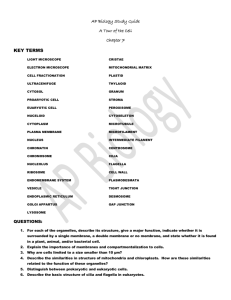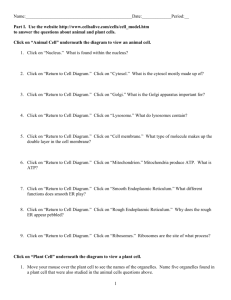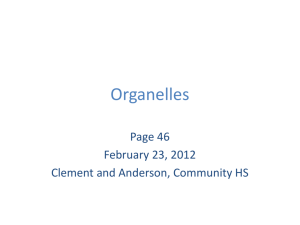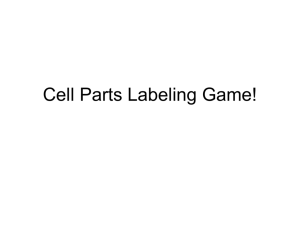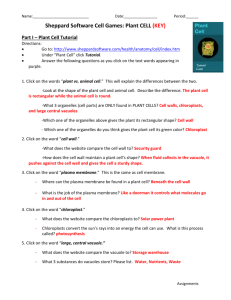AP Organelle Notes
advertisement
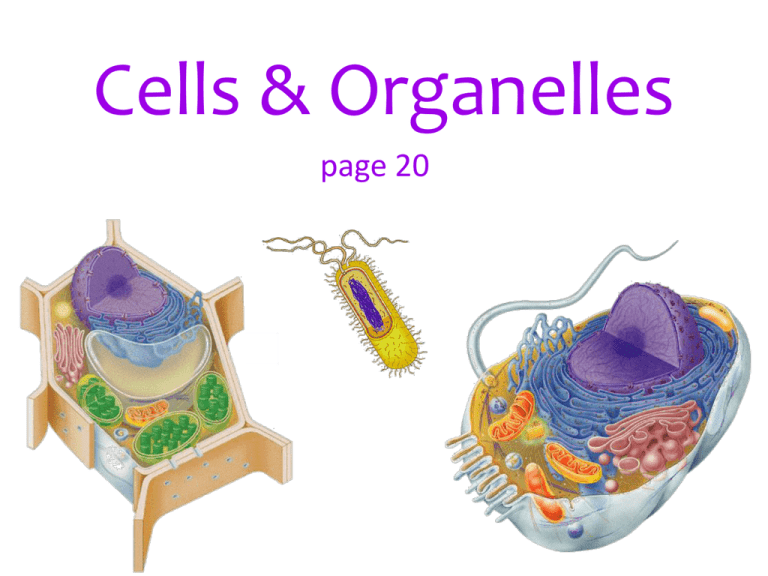
Cells & Organelles page 20 Organelles? Golgi • Specialized structures with specialized functions • Containers / Organization • Membranes as sites for chemical reactions chloroplast mitochondria Cells have to work to live… • What do cells have to do? – Make proteins • Proteins control EVERY cell function – Make energy • For daily life & growth – Food & water storage – Maintain homeostasis – Movement – Miscellaneous Building Proteins • Organelles involved: – – – – – Nucleus Ribosomes Endoplasmic Reticulum (ER) Golgi apparatus Vesicles THE PROTEIN ASSEMBLY LINE Nucleus Ribosome ER Golgi apparatus Vesicles Nucleus • = contains DNA – genetic information • Known as the “control center” of the cell • Gives the instructions for protein synthesis Ribosomes • = Site of protein production (where proteins are made) • RNA gets the code from DNA and takes it to the ribosomes • They look like small dots! Making Energy • Cells must convert incoming energy to forms that they can use for work • Organelles involved: – Mitochondria • Glucose ATP – Chloroplast • Sunlight Glucose ATP Mitochondria • = where energy (ATP) is made • Known as the “powerhouse” of the cell • Contains folds called cristae – If you INCREASE the surface area (# of folds), MORE energy is made! Chloroplast • = where photosynthesis takes place – Makes GLUCOSE! • ONLY PLANT CELLS HAVE CHLOROPLAST! – Remember photosynthesis is the reaction plants use to make their own food Food & Water Storage • Organelle involved – Vacuole Vacuole • = stores waste (mostly water) • Larger in plant cells than animal cells – Plants need to absorb excess water – Larger Vacuole = More water – Smaller Vacuole = Less water Maintain Homeostasis • Stable internal environment • Organelle involved: – Plasma membrane Plasma Membrane • = responsible for maintaining a stable, internal environment AKA HOMEOSTASIS – It allows certain materials in to and out of the cell • Known as the “gatekeeper” – AKA : • Semi-permeable • Cell Membrane • Phospholipid Bilayer Plasma Membrane • Made of many PHOSPHOLIPIDS – Heads: Hydrophilic (Water loving) – Tails: Hydrophobic (Water fearing) Movement • Organelles involved: – Cilia – Flagella Cilia & Flagella • Cilia = movement; short, hair-like structure • Flagella = movement; long, whip-like structure Cell Wall • = provides structure and support to PLANT cells • ONLY PLANT CELLS HAVE A CELL WALL • Located on the outside of the plasma membrane Cytoplasm • = gel-like substance throughout the cell that holds the organelles in place



